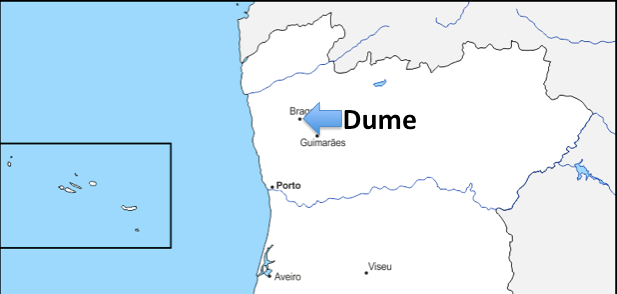
A European Journey #12 – Dume (Portugal)
The birth of Portugal
Today we travel to Portugal, more precisely to the former parish of Dume, which is nowadays a suburban area of Braga. It is located in the mountainous area of Northern Portugal.
At first glance this location doesn’t seem to have much to attract tourists, who would rather visit the beautiful old town of Braga. And yet Dumehas a lot to tell about the earliest foundations of Christianity in Portugal.
We will walk specifically along a cobblestone street called Rua São Frutuoso. Therewe find a small whitechurch called Igreja de São Martinho de Dume. Next to the church lie the ruins of an ancient basilica built on top of the burial place of Martin of Dume (or of Braga). The two people mentioned in these names, Frutuoso (or Fructuosus) and Martinho (or Martin) turn out to be the two key figuresin the history of Portuguese Christianity.
The Christianization of Portugal happened in two phases led respectively by Martin and Fructuosus.
The first phase took place in the 6th century with Martin (who should not be confused with Martin of Tours). Martin was from Pannonia (modern-day Hungary). On a pilgrimage to the Holy Land he was strongly impacted by one of the earliest forms of monasticism, the ascetic Desert Fathers.
When he returned to Europe, he settled in Gallaecia (modern-day Northern Portugal and Galicia). This was the land of the Suevi, a former Germanic tribe that had settled there and who were not pagan but Arian. Martin played a key role in the conversion of the king of the Suevi, which eventually turned the whole kingdom to Christianity.
At that time Dume was the capital of the kingdom. This is also where Martin built his first monastery. His order followed the Apophthegmata Patrum (literally the Sayings of the Father), the foundational document of the Desert Fathers, which he had translated himself.
Martin also exercised a strong influence on the Portuguese language. For example, he changed the Latin names for the days of the week, because they were derived from pagan gods. Monday became second day; Tuesday third day, and so on. Saturday became the day of the Sabbath (sabado) and Sunday the day of the Lord (domingo). While most European languages have kept the Latin system, the Portuguese language still uses Martin’s system.
The second phase of the Christianization of Portugal occurred a century later with Fructuosus. He was born in the region of Toledo and was a descendant of the Visigoths. This tribe, which had been neighbour to the Suevi, had taken over their kingdom in the meantime.
Fructuosus, who had clearly been influenced by the ascetism of Martin, founded his own monastic movement in Galicia and Northern Portugal. Contrary to the Irish model that we saw last week, the Portuguese model was more hierarchical. One of the reasons was that the Germanic tribes were more influenced by the sense of order they could find in Christianity, which was in clear contrast with the wildness of their ancestors.
These monasteries followed two rules: the Regula Monachorum (rule of the monks) which focused on the personal discipline of the monk; and the Regula Abbatum (rule of the abbey), which was intended to organise life in the community. While some of the rules could seem too harsh to us today, a strong emphasis was placed on caring for the poor and for the sick.
Fructuosus designed four types of monasteries. There were monasteries for singles, double monasteries for single men and women living separately in the same abbey, monasteries for families and monasteries for the nobility. Quite remarkably, most of the mountain villages between the rivers Douro and Minho were probably founded by these family monasteries.
This Portuguese monastic order was an entirely local expression of Christianity, and remained independent from papal influence for several centuries. Both Martin’s and Fructuosus forms of monasticism deeply recreated the social fiber of the Portuguese and Galician societies after the chaos caused by the Germanic invasions.
However the Arabic invasions of the eighth century brought further changes in Portugal. Slowly the Benedictine order (which was under papal rule) replaced the old expression of monasticism. And by the eleventh century, all the monasteries in Portugal and Spain were under the authority of the pope.
Martin and Fructuosus have strongly shaped Portuguese spheres of life such as family, village life, healthcare, welfare, language and literature, to name but a few.
So while the old town of Braga is worth visiting, surely a little detour to Dume would not be a loss of time either.
See you next week somewhere else in Europe.
Cédric Placentino
Schuman Centre convener for Italian and French Europe
Follow A European Journey here.

This Post Has 0 Comments